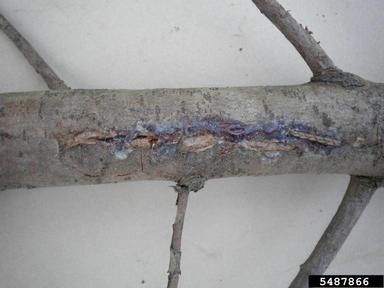Seiridium Canker
Seiridium canker, also known as Cypress canker, was first reported in California in the late 1920s and has since spread throughout North America and into Florida wherever Cupressaceae (cypress family) grow. The disease has raised some concern in Florida due to the damage and mortality observed on Leyland cypress. Leyland cypress can be killed or severely disfigured by the disease. Disease management considerations and tree replacements with resistance to Seiridium canker are recommended.

The symptoms of Seiridium canker most often appear as "flag" branches where individual branches fade from green to yellow to reddish-brown due to girdling cankers. Infection may affect a single branch or multiple branches throughout the tree and mortality of the entire tree is common. Closer examination reveals oval cankers that are sunken and often reddish with resin exuding from the margins, especially on new, rapidly expanding cankers.
The fruiting bodies (pycnidia) are the only sign observed, are black and appear as small pustules (blisters) (0.3–15 mm in size) that break through the bark during wet weather that open to release the spores (conidia).
Disease management options for Seiridium canker are limited. Although individual high-value trees may be protected by fungicides and pruning out individual infected branches might prolong survival of susceptible trees, planting either resistant species or varieties is the only realistic option for long-term disease control. In Florida, Leyland cypress has been widely promoted and planted in ornamental settings when other species are better adapted. Leyland cypress is a hybrid between two Pacific coast species that are native to cool climates and unsuited to Florida's hot and dry seasons. This leads to drought stress for trees on many sites in Florida and predisposition to Seiridium spp. as well as other fungal and insect pests.
Conifer species better adapted to Florida growing conditions, less likely to be drought-stressed, and with resistance to Seiridium spp appear in Table 1. Two native tree species, southern red cedar (Juniperus silicicola) and Atlantic white cedar (Chamaecyparis thyoides) are well adapted to Florida conditions (if local seed origins are used) and possess qualities similar to those of Leyland cypress. These qualities include fast growth, easy propagation, dense pyramidal shape and good drought tolerance once the tree is established. A few exotic species are worth trying in Florida and have previously performed well in the region. Plant several species and cultivars to maintain diversity in the landscape and prevent disease outbreaks in the future.
